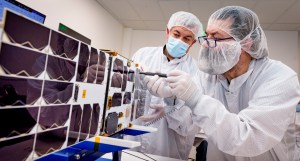NASA’s Perseverance Captures ‘Googly Eye’ During Solar Eclipse
The tiny, potato-shaped moon Phobos, one of two Martian moons, cast a silhouette as it passed in front of the Sun, creating an eye in Mars’ sky. From its perch on the western wall of Mars’ Jezero Crater, NASA’s Perseverance rover recently spied a “googly eye” peering down from space. The pupil in this celestial […]
4 min read
Preparations for Next Moonwalk Simulations Underway (and Underwater)
The tiny, potato-shaped moon Phobos, one of two Martian moons, cast a silhouette as it passed in front of the Sun, creating an eye in Mars’ sky.
From its perch on the western wall of Mars’ Jezero Crater, NASA’s Perseverance rover recently spied a “googly eye” peering down from space. The pupil in this celestial gaze is the Martian moon Phobos, and the iris is our Sun.
Captured by the rover’s Mastcam-Z on Sept. 30, the 1,285th Martian day of Perseverance’s mission, the event took place when the potato-shaped moon passed directly between the Sun and a point on the surface of Mars, obscuring a large part of the Sun’s disc. At the same time that Phobos appeared as a large black disc rapidly moving across the face of the Sun, its shadow, or antumbra, moved across the planet’s surface.
Astronomer Asaph Hall named the potato-shaped moon in 1877, after the god of fear and panic in Greek mythology; the word “phobia” comes from Phobos. (And the word for fear of potatoes, and perhaps potato-shaped moons, is potnonomicaphobia.) He named Mars’ other moon Deimos, after Phobos’ mythological twin brother.
Roughly 157 times smaller in diameter than Earth’s Moon, Phobos is only about 17 miles (27 kilometers) at its widest point. Deimos is even smaller.
Rapid Transit
Because Phobos’ orbit is almost perfectly in line with the Martian equator and relatively close to the planet’s surface, transits of the moon occur on most days of the Martian year. Due to its quick orbit (about 7.6 hours to do a full loop around Mars), a transit of Phobos usually lasts only 30 seconds or so.
This is not the first time that a NASA rover has witnessed Phobos blocking the Sun’s rays. Perseverance has captured several Phobos transits since landing at Mars’ Jezero Crater in February 2021. Curiosity captured a video in 2019. And Opportunity captured an image in 2004.
By comparing the various images, scientists can refine their understanding of the moon’s orbit to learn how it’s changing. Phobos is getting closer to Mars and is predicted to collide with it in about 50 million years.
More About Perseverance
Arizona State University leads the operations of the Mastcam-Z instrument, working in collaboration with Malin Space Science Systems in San Diego, on the design, fabrication, testing, and operation of the cameras, and in collaboration with the Niels Bohr Institute of the University of Copenhagen on the design, fabrication, and testing of the calibration targets.
A key objective for Perseverance’s mission on Mars is astrobiology, including the search for signs of ancient microbial life. The rover will characterize the planet’s geology and past climate, pave the way for human exploration of the Red Planet, and be the first mission to collect and cache Martian rock and regolith (broken rock and dust).
Subsequent NASA missions, in cooperation with ESA (European Space Agency), would send spacecraft to Mars to collect these sealed samples from the surface and return them to Earth for in-depth analysis.
The Mars 2020 Perseverance mission is part of NASA’s Moon to Mars exploration approach, which includes Artemis missions to the Moon that will help prepare for human exploration of the Red Planet.
NASA’s Jet Propulsion Laboratory, which is managed for the agency by Caltech in Pasadena, California, built and manages operations of the Perseverance rover.
For more about Perseverance:
https://mars.nasa.gov/mars2020
News Media Contacts
Karen Fox / Molly Wasser
NASA Headquarters, Washington
202-358-1600
karen.c.fox@nasa.gov / molly.l.wasser@nasa.gov
DC Agle
Jet Propulsion Laboratory, Pasadena, Calif.
818-393-9011
agle@jpl.nasa.gov
2024-150
Share
Details
Related Terms
What's Your Reaction?















































